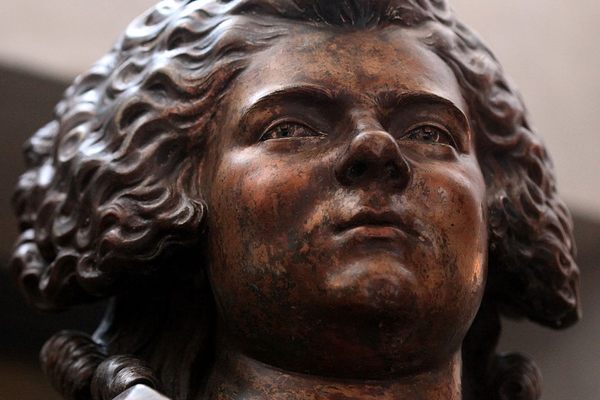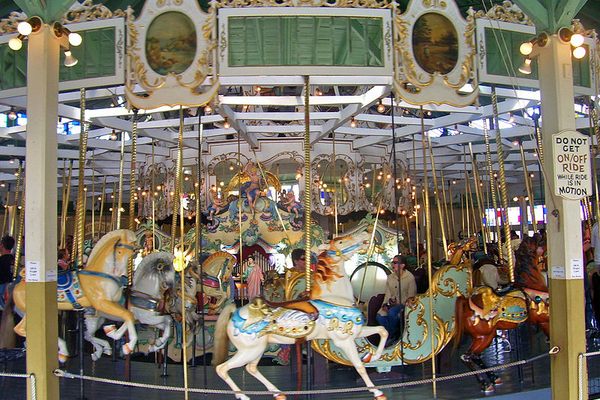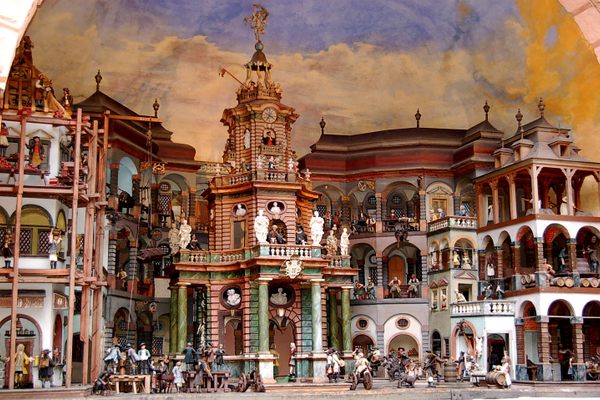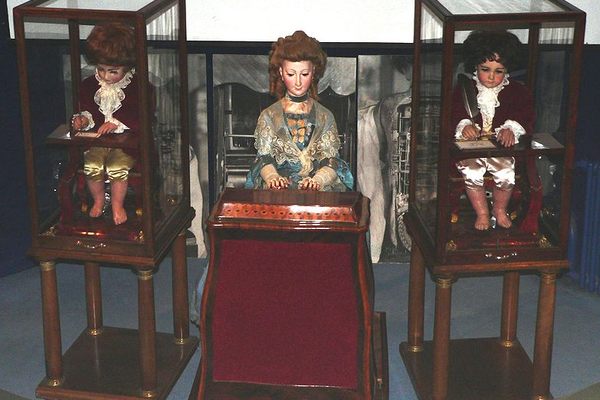Canard Digérateur de Vaucanson (Vaucanson's Digesting Duck)
Vaucanson's most famous automaton, brought back to life.
All that was left of the most famous of all automatons were a pair of heat-warped wings found among the smoking ruins of a museum in Krakow, Poland in 1889.
Built in 1739 by Grenoble artist Jacques de Vaucanson, the Digesting Duck quickly became his most famous creation for its lifelike motions, beautiful craftsmanship, and it’s ability to poop out food it had eaten. This simulacrum of life was the ultimate goal for Enlightenment automata builders, both for entertainment and for scientific/philosophical reasons. He built his master works - the duck and two life-sized humanoid musicians - in Paris, after several earlier attempts at mechanical devices and automata.
The duck sat on an enormous base housing the mechanics, and was life-sized, constructed of hundreds of parts covered in perforated gold-plated copper to allow a view of the inside workings. When activated, it moved like a duck, wiggling its beak in the water, quacking, and re-adjusting its position. Most famously though, it could eat pellets offered to it, and then, after “digestion”, poop them out the other end.
Voltaire was suitably impressed, and wrote, “Without Vaucanson’s Duck, you have nothing to remind you of the glory of France.” Just how sarcastic or not he may have been is left to the imagination.
It quickly became a super-star attraction, but Vaucanson tired of them only a few years later, packing them off for a grand tour with caretakers. He turned his attention to a new assignment of designing automated looms for France’s silk industry, leading to a colorful chapter in his life wherein, upon introducing an automated loom needing only the expertise of a donkey for man-power, the silk workers revolted causing Vaucanson to flee the area disguised as a monk.
In the meantime, the automatons changed hands. In 1805, Johann Goethe saw the duck in the private collection of German eccentric Gottfried Christoph Beireis, along with the disabled remains of his two other famous automatons, and remarked in his diary,”The Vaucansonian automatons were utterly paralyzed… A duck without feathers stood like a skeleton, still devoured the oats briskly enough, but had lost its powers of digestion.”
Repaired for the occasion, the duck made its last formal appearance at the Exposition Universelle at the Palais Royal in Paris in 1844. The illusionist and automata maker Robert-Houdin was employed after the exposition to repair damages to a wing. During his repairs, he took the opportunity to turn a critical eye to the famous digestive tract of the duck, and announced triumphantly, “I found that the illustrious master had not been above resorting to a piece of artifice I would happily have incorporated in a conjuring trick.” The duck poop was in fact stored in a separate hidden compartment, a mechanical slight of hand, not the result of artificial duck digestion.
In the years after this, the duck disappeared into obscurity until spotted among the collection of a Krakow museum. Unfortunately, a fire destroyed the building, the two partially destroyed wings taken as evidence of its demise. Since the it has grown in reputation, showing up as motifs in film, art, and literature, notably in Thomas Pynchon’s novel Mason & Dixon, Vaucanson’s duck comes alive and terrorizes a French chef with its Bec de la Mort (“Beak of Death”).
The excellent copy on display at the Museum of Automatons in Grenoble was created in 1998 by Frédéric Vidoni a builder and restorer of automata. The Musée des Automates is a small collection assembled by Francis Lara of music boxes and auomatons, and the duck its star attraction.
In an interesting recent development, in Gaby Wood’s 2002 history of automata Edison’s Eve, the author mentions that “some mysterious photographs have come to light in the archives of the Conservatoire National des Arts et Métiers in Paris” (situated on a street now called rue Vaucanson). They show a crude, featherless bird, made of spring-like windings of wire and perched on a huge wooden frame that contains a mechanism resembling a watermill. They are extraordinary views, reminiscent of the sorry skeleton Goethe described.”
Both the provenance of the photos and the item pictured are in doubt. It may show a copy, or the insides of a different contraption. However, it is interesting to note that after Vaucanson died in Paris in 1782, his collection, originally donated to Louis XVI ultimately became the foundation of the Conservatoire des Arts et Métiers (the educational organization which maintains the Musee des Arts et Métiers).
For now, a painstaking and beautiful reproduction shall have to suffice.
Know Before You Go
The museum is closed.
Community Contributors
Added by
Edited by
Plan Your Trip
The Atlas Obscura Podcast is Back!





















Follow us on Twitter to get the latest on the world's hidden wonders.
Like us on Facebook to get the latest on the world's hidden wonders.
Follow us on Twitter Like us on Facebook